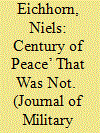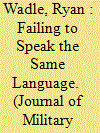|
|
|
Sort Order |
|
|
|
Items / Page
|
|
|
|
|
|
|
| Srl | Item |
| 1 |
ID:
175860


|
|
|
|
|
| Summary/Abstract |
When historians study the short nineteenth century (1815–1914), they usually see the century as one of peace. The assumption rests on the perception that European Great Powers did not engage in major wars with each other. Contrary to such assumptions though, the nineteenth century was a violent period with frequent and often bloody localized or regional wars. Some of these wars involved one or more of the Great Powers. Especially the middle decades of the nineteenth century witnessed a series of wars. Despite the massive bloodletting during the American Civil War, conflicts in Asia and South America were far more devastating. This essay demonstrates that the middle decades of the nineteenth century witnessed ruinous conflicts as military technology exceeded battlefield tactics with many soldiers suffering deadly consequences.
|
|
|
|
|
|
|
|
|
|
|
|
|
|
|
|
| 2 |
ID:
175863


|
|
|
|
|
| Summary/Abstract |
Mission 204, a mixed British and Australian force, operated in Nationalist China from 1942 to 1945 with the objective of training Nationalist guerrillas. Historians have tended to focus only on the mission's record in 1942, when British and Australian commandos deployed to eastern Jiangxi Province and suffered from a high incidence of disease. This paper not only reframes the narrative concerning 1942, but also argues that the mission met with success from 1943 to 1945, due to adaptations in the mission’s force structure and an increased willingness to suit Chinese desires.
|
|
|
|
|
|
|
|
|
|
|
|
|
|
|
|
| 3 |
ID:
175862


|
|
|
|
|
| Summary/Abstract |
Between the world wars, senior officers in both the U.S. Army and U.S. Navy sought to create an interservice culture through the integration of strategic planning, professional military education, and, most importantly, the conduct of large-scale joint exercises. Rather than solely emphasizing the issue of command arrangements that dominate previous studies, this study highlights a number of factors that complicated efforts to cooperate, including disagreements over individual service responsibilities, the advent of new technologies and capabilities, and the cultural divide between the services. Ultimately, these measures to institutionalize coordination and regular joint training fell short of their intent and left a mixed legacy.
|
|
|
|
|
|
|
|
|
|
|
|
|
|
|
|
| 4 |
ID:
175858


|
|
|
|
|
| Summary/Abstract |
The Japanese ninja are known in the west mainly by the romantic image of the secret agent, or assassin, endowed with superhuman powers. Yet there is a lack of serious scholarship on the actual warriors who became the subject of the myth. This paper seeks to use the full extent of primary sources from the period to offer a blueprint for a historical, rather than mythical understanding of the ninja. They did not belong to a unified class, but were instead a hodgepodge of heterogeneous groups, united only by their skills in irregular warfare. They became “ninja” only retrospectively, as a result of the historical imagination of later generations.
|
|
|
|
|
|
|
|
|
|
|
|
|
|
|
|
| 5 |
ID:
175861


|
|
|
|
|
| Summary/Abstract |
For the past eight years the authors have been engaged in a debate with Dr. Brian N. Hall regarding the role of British continuous wave (CW) wireless in WWI. Dr. Hall contended the British army did as well as could be expected in applying this technology to warfare. The authors compared British developments to much faster, although later, American development. The French army, however, deployed this technology much earlier than either. New evidence shows that though aware of the French achievement the British chose not to exploit it.
|
|
|
|
|
|
|
|
|
|
|
|
|
|
|
|
| 6 |
ID:
175864


|
|
|
|
|
| Summary/Abstract |
This article describes the interactions between Kursk Oblast’s civilian leadership and the Soviet military during the latter’s winter 1943 operations. In this period, the Red Army incorporated the liberated people into its rear services area while returning civilian leaders reestablished Soviet power. Operating at cross-purposes at times, both sides still found enough common cause to prepare the Red Army for its first summertime victory in the war. By examining the working relationship of the Red Army and the civilians situated so close to the enemy, this article offers new insights into an often overlooked region of the “home front” in studies of World War II.
|
|
|
|
|
|
|
|
|
|
|
|
|
|
|
|
| 7 |
ID:
175859


|
|
|
|
|
| Summary/Abstract |
This article examines the 1709 French campaign in Flanders. It focuses on the dynamics between logistics and strategy. Chronic shortages of pay and provisions provoked a vigorous debate within the French military leadership over how the Army of Flanders should be used. Marshal Villars, the commander in the field, pushed for aggressively seeking battle with the enemy. Louis XIV and his advisers at Versailles advocated a cautious defense. This debate was eventually resolved in the king's favor. The strategy implemented in Flanders did not just result in the survival of France during its moment of greatest weakness. It also provided a model for the French high command for the remaining years of the War of the Spanish Succession.
|
|
|
|
|
|
|
|
|
|
|
|
|
|
|
|
|
|
|
|
|